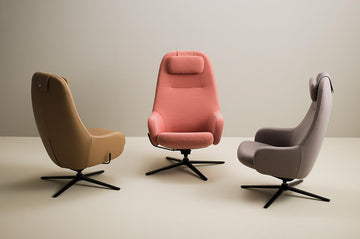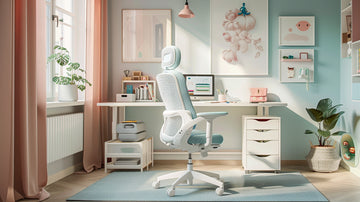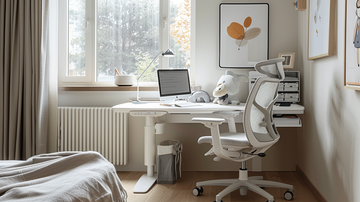What is an Ergonomic Chair?
To understand what an ergonomic chair is, one must first understand what ergonomics is. Ergonomics is a branch of science that studies the interaction between persons and the components of the systems in which they work. The main goal of ergonomics is to boost a system's productivity by providing users with a completely comfortable and supported environment.
Ergonomic chairs are another result of this study, which have been utilized to help users focus more on their job by improving posture and reducing back and neck pain, which could have led to other ailments. Ergonomics chairs are commonly employed in companies and offices where employees must remain in the same location for lengthy periods of time, such as a 9 to 5 job done solely on a computer screen. Ergonomic seats can also help freelancers be more productive while working from home.
Importance of Ergonomic Chair
Ergonomic chairs can help you avoid certain illnesses such as deep vein thrombosis in which a clot is formed in a deep vein. It mostly occurs in the lower portion of the body such as the legs due to immobility. Cervical spondylosis is another illness that causes inflammation of the joints and discs in the neck spine. It usually occurs when one is focused on something without tilting his neck, especially if there is no neck support.
Adjustable pieces of the ergonomic chairs help you get a perfect personalized posture that protects you from such ailments. When you are no longer at risk of such illnesses, you are more likely to concentrate on your task. It has the ability to bring forth the "Productive You" while enhancing your abilities. Completing your job on schedule and without showing symptoms of exhaustion might earn you respect among your coworkers.
What Makes a Chair Ergonomic?
The word "ergonomic chair" does not relate to a specific style of the chair; rather, it refers to the various elements added or adjusted by manufacturers to give correct support and improve posture while sitting. These qualities of an ergonomic chair won't be sufficient to alleviate all of your work-related health problems if you don't know how to sit properly to avoid them. As an illustration: Maintain a distance of at least an arm's length between you and your computer screen. The monitor's top should be at your eye level. Avoid slouching by sitting up straight. The position of your neck should be neutral and relaxed. Your legs must not be crossed and should be straight to ease blood circulation.
The office chairs and study chairs are being improved day by day to make them more comfortable than before. But a comfortable chair is not necessarily ergonomic. Some of the elements which make a chair ergonomic are:
Swivel base
The swivel base in the chair allows the seat to be turned in any direction or through 360°. The swivel base of the chair facilitates movement, allowing users to access various portions of their workspaces or desks without exerting unnecessary effort. Swivel chairs are more ergonomic than other types of chairs because they allow for more comfortable movement in all directions rather than forcing you to turn awkwardly while seated. If you need to move around with lower back pain, these will relieve any pressure on your lower back. If you're a nursing mother, a swivel base can let you move your baby around gently while causing the least amount of disruption to his nap.
Adjustable Seat Height
If a chair does not allow for seat height adjustment, it is not considered ergonomic. It's a crucial feature that allows users to match their body size to the height of their workbench. The length of the chair can be adjusted to suit one's needs. The ideal position for the hips is to be below the knees and the feet to be on the ground. If your feet do not touch the ground and you are shorter, you should choose an ergonomic chair with a footrest.
Adjustable Arm Height and Width
Armrests help to relieve upper-body strain and allow the shoulders to relax. Arms should not be used when typing since they impede total arm movement; nevertheless, if you must use the arms while typing, their width should be adjustable and extra support should be provided to the arm so that your wrist does not hurt. The armrest should meet the level of your relaxed arm, it should neither be too high nor too low. Ergonomic chairs have armrests that are adjustable to meet the height of your arm.
Moveable Headrest
An ergonomic chair does not need to have a headrest. Some individuals don't even consider it to be a part of it. But when a headrest is included in an ergonomic chair, it must be adjustable so that the user can keep his head straight while looking on the screen and then lay it back for a 2-minute rest period.
Backrest with Lumbar Support
You probably don’t want spine injuries, back pain, and stiff shoulders. That’s what the backrest in ergonomic chairs is for. The adjustable portion of the backrest that supports your lower spine region is known as the lumbar support. It can be adjusted with the height adjustment mechanism in some chairs and independently in others. The pressure this portion applies to the lower back can also be adjusted in some specifically designed chairs.
Seat slider
A seat slider or a seat pan adjustment is a lever that allows you to control the distance between your seat and the chair's back. It changes the depth of your seat so that there is a gap of 1-4 inches between the front edge of your seat and the back of your knee. In this way, this ergonomic feature allows for better leg support as well as blood flow. It also ensures that your back is properly pressed against the chair's back.
Angle adjustment
This feature allows you to adjust the chair's back to a more comfortable angle. It can assist in bringing diverse positions to your body and increasing your body's motility. It aids bodily relaxation.
Comfortable material
The seat must be covered with a fabric that is breathable, non-slip, and easy to clean in order to ensure the chair's longevity. The more the material is soft the more the chair is comfortable.






